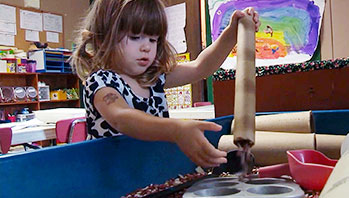- bulbs
- plastic fruits and vegetables
- sand (or dirt)
- seeds and seed pods (maple, walnuts, chestnuts, acorns, etc.)
- small sticks
- thick leaves (orchid, pineapple, etc.)
- toy shovels
- bulb
- plant
- seed
- underground
MA Standards:
Language/L.PK.MA.6: Use words and phrases acquired through conversations, listening to books read aloud, activities, and play.
Speaking and Listening/SL.PK.MA.1: Participate in collaborative conversations with diverse partners during daily routines and play.
Head Start Outcomes:
Logic and Reasoning/Reasoning and Problem Solving: Classifies, compares, and contrasts objects, events, and experiences.
PreK Learning Guidelines:
English Language Arts/Language 2: Participate actively in discussions, listen to the ideas of others, and ask and answer relevant questions.
Above Ground or Underground

© Commonwealth of Massachusetts, Department of Early Education and Care. All rights reserved.
Skill Focus: Fine Motor Skills, Vocabulary
Fill the table with sand or dirt. Place various (real, sturdy) plant materials and plastic plants in the sand (dirt).
- Tell children they have to use the shovels and dig for as many plant items as they can find.
- Explain that once they have a collection of plant items they need to decide which ones belong above ground and which ones belong underground.
- Have children describe each plant part before reburying them or setting them above ground.
Adaptation: If you do not have a sand table, use a large plastic bin with a cover. That way, you can cover the activity when not in use.
